| 2008 G.A.L. Convention Presenters |
|
| Overveiw | Presenters | Music | Exhibition | Auction | Miscellaneous | Open House | Staff & Helpers |
|
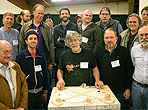 |
There is so much lutherie info happening at GAL Conventions that we have to throw it around with metaphorical shovels. We got off to a quick start on Wednesday afternoon when Tom Ribbecke demonstrated and explained his jig for shaping and fitting archtop guitar braces. Here he is with the jig and a few of the folks who attended the workshop. Some of the people visible in the photo are (roughly left to right) Alberto Paredes, Todd Rose, Tim Frick, Steven Dewey, Trevor Healy,Mathew Jacobs, Steve Kinnaird, Bill Henry, Jeff Elliott, Michael Madigan, and Gary Van Asdale. |
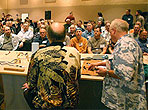 |
Guitar repair Uber Hombres Frank Ford and Dan Erlewine were back for more of their popular illustrated demos. Here’s the view from their side of the bench. |
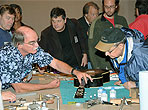 |
Frank Ford did a complete fret job on this guitar while the crowd watched. Afterward, workshop attendees came forward to inspect his work. |
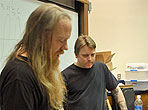 |
Magnetic pickup experts Jason Lollar (left) and Erick Coleman (of Stew-Mac) presented a workshop on pickups and control circuitry. |
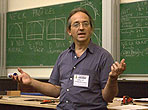 |
Longtime GAL member and lutherie teacher David Freeman of Timeless Instruments gave us the lowdown on the geometry of string action, and other design factors affecting playability. |
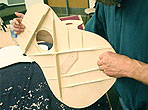 |
Dana Bourgeois has done the final brace trimming on thousands of steel string guitars in his work under his own brand, with PRS, and now with Pantheon Guitars. He lectured on the theory of his work, then followed up with a hands-on demonstration of the process and sound of his method. |
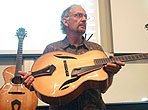 |
A panel of big names in the archop field discussed the present state of the instrument, and their ideas on its future. Tom Ribbecke (pictured in photo 1) shared the panel with Steve Grimes (pictured here) and Ted Megas (pictured in photo 8). Steve also gave a workshop on his recent work with low-stress archtops. |
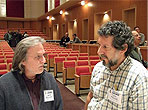 |
Panelist Ted Megas (right) and moderator Jeff Elliott prepare for the Archtop panel in beautiful Lagerquist Hall. |
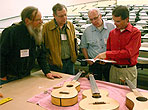 |
James Buckland explains his reproductions of pre-classical guitars to Blaine England, Stanton Alger, and Helmut Sontag after his workshop on 19th-century lutherie techniques. |
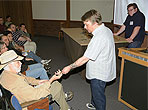 |
Erick Coleman was back, this time with Elliott John-Conry, to give a workshop on Electric Guitar Hardware Upgrades, Choices, and Setup Tips. |
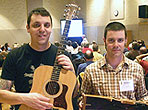 |
Brian Michael (right) is the new guy from Frank Ford’s shop. He gave a workshop demonstration of installing acoustic guitar pickups. |
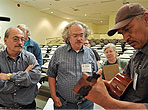 |
Alberto Paredes (left) presented a workshop on the History and Development of Colombian Andean Stringed Instruments. Alberto is a 31-year GAL member who came all the way from Bogota Colombia to be with us. Here Abel Sua tries out an instrument made by Sr. Paredes, while Tim Williams looks on. |
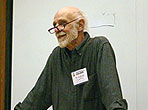 |
Lutherie legend Eugene Clark engaged in an enlightening and far-ranging discussion based on his recent American Lutherie article on the Spanish solera. |
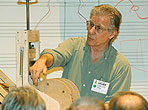 |
Speaking of legends, Charles Fox is king of the lutherie teachers, and the guy who taught the world to bend guitar sides with light bulbs. Now he’s overthrown his own Revolutionary Hunta by designing the side bender of the future. Watch American Lutherie magazine for complete information. (That’s the old-fashioned model in the photo.) |
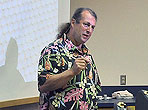 |
Bob Gleason has been building ukuleles in Hawaii since Roy Smeck was a baby. OK, that’s hyperbole, but literally before John Mayer was born. Anyway, he shared thoughts and techniques on Ukulele Making for Guitar Makers. Follow this link to see Carl Bernhardt examining one of Bob’s sample soundboards. |
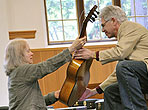 |
Long-time American Lutherie Contributing Editor Cyndy Burton moderated this time’s classical guitar listening session. Here she hands the next instrument to Peter Zisa, the player for the session. |
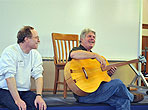 |
Frequent author and convention presenter Harry Fleishman plays a bass built by American Lutherie Contributing Editor RM Mottola (left) at the bass listening session. Harry is a bass maker among his many talents, and he moderated a panel on electric bass and electric upright bass design. |
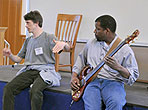 |
Two more bass makers at the bass listening session. That’s David King on the left and David Minnieweather on the right. David Minnieweather was a member of the aforementioned bass design panel. Here he is playing a bass by Ralph Dammann. |
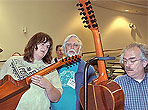 |
Rounding out the bass design panel was Veronica Merryfield (left). Here she discusses an innovative baritone bandola by Alberto Paredes with Don Bradley. |
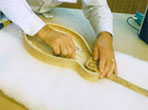 |
Roger Siminoff has been a force on the lutherie scene since the 1970s through his books and articles. He demonstrated his latest advancements in tuning the resonances of archtop mandolins. |
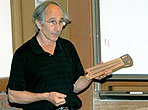 |
If there is a granddaddy of the American lutherie boom, Michael Gurian just might be the guy. He spoke on the life and work of his former student, the late classical guitar innovator Tom Humphrey. |
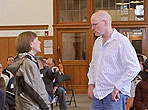 |
This time’s listening sessions were held in Xavier Hall, converted from the university’s original library. Here Mike Doolin prepares to moderate the steel string listening. Mark Swanson was the designated player. |
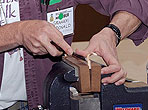 |
Australian lutherie book author Graham McDonald presented a hands-on workshop covering several different concepts for bracing mandolin soundboards. |
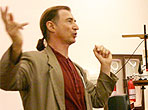 |
Innovative violin maker Joseph Curtin’s lecture gave an overview of some new directions in violin design. He followed it up with a workshop demonstration of a testing rig he has developed to analyse the tap tones of violins and other instruments. Follow this link to see it. Joseph is shown at left, with Evan Davis (center) and Fan Tao (right). |
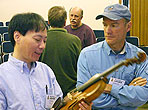 |
Fan Tao lectured on the physics of violin and guitar strings. He’s the head of R&D at D’Addarrio, the world’s largest manufacturer of music strings. Here he discusses the test violin with David Dolak. |
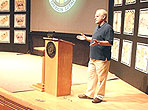 |
Our final lecture was by classical guitar maker Michael Cone and entitled “Practical Acoustics: An Oxymoron?” Michael stepped us through his development of new techniques for analysing the resonances of a guitar, and showed how he used the information to replicate the sound of a guitar he had built many years earlier. |
Top of Page |
|
